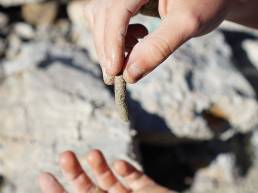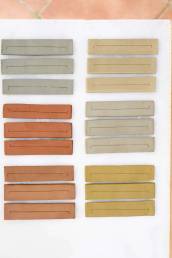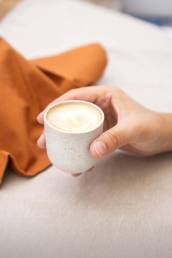LAND OF CLAY
Tierra de Arcillas WAS CREATED WITH THE AIM OF ENHANCING THE VALUE OF THE LOCAL CLAY RESPECTING THE ENVIRONMENT
The official track of Badlands 2022 visits for first time the Valley of Andarax, an oasis in the middle of a harsh landscape where the mountains over 3.000m of Sierra Nevada turn into the Tabernas Desert.
Located in the heart of the valley, the project Tierra de Arcillas (Land of Clay) was created by Julia and Milena, designers based in Barcelona until they moved to Almería to grow this project through the investigation with the local clays.
Our own logo shows our respect for this kind of soil and terrain, being even a part of our identity. This fact, together with our love for coffee -for some reason closely linked to the cycling community- allowed us to combine these passions, taking coffee directly from a piece of Badlands while we chatted with them.


1. What’s the story and the motivations behind Tierra de Arcillas?
After several years working with industrial clays, we realized that we really did not know the origin of the material with which we were in contact. We tried to investigate about it, but we realized that it was very difficult to trace the origin of the clay. The traditional potters produced their pieces with local clay, but currently that connection has been lost, and that is which gives to each piece its own characteristics.
We wanted to return to that origin where the land is the protagonist. We settled in Almería for that reason, we decided to undertake this project, rediscovering our environment in search of the resources that we had around us. And we were very surprised to see that we were surrounded by so many types of clay which conform this particular landscape. We are indeed in a land of clay.


2. Besides the characteristics of these clays, you value their origin. Why this land and these landscapes are so special for you?
After many years living in Barcelona, we decided to return to Julia’s hometown, Almería. We settled in a small house in the village of Íllar, La Alpujarra, where we set up our workshop.
We found there our first local clay, when a relative showed us a place where he used to make marbles to play with when he was a child. That fact made us to keep rediscovering the land with new eyes, and it was then that we realized the impressive landscape that surrounded us.


3. How can this kind of projects help to restore the environment?
One of the main purposes of our project is to reconnect people with nature and raise awareness of the materials and their origin, as well as the protection of the environment. That is why we are committed to a environmentally conscious production, avoiding overexploitation of the territory and trying to use the natural resources discarded by other industries.
Besides this, we are committed to the rural environment and decentralization, creating new interests and activities that enhance the tourism that respects the environment.


4. Could you tell us about the types of clay you work with?
We have found a great variety of clays around us: in Sierra de los Filabres, La Alpujarra, in the Valley of Andarax… but right now we are mainly focused on two of them.
The first is Marga, a calcareous clay with greenish-yellowish tones that, once cooked at a high temperature, makes pieces of white speckled tones. We collect this clay in Íllar, next to our workshop.
The second is Launa, a dark-colored soil typical of this area. This clay has been used for centuries to waterproof the houses in La Alpujarra. Cooked at a high temperature, it gives our pieces shades that can range from gray to reddish brown.
The high temperature process (1.230C) make the pieces more resistant and durable, suitable for a daily use, dishwashers and microwave. The transparent varnish inside in contrast to the unvarnished exterior makes us in direct contact with the natural clay, making the experience a unique moment.






